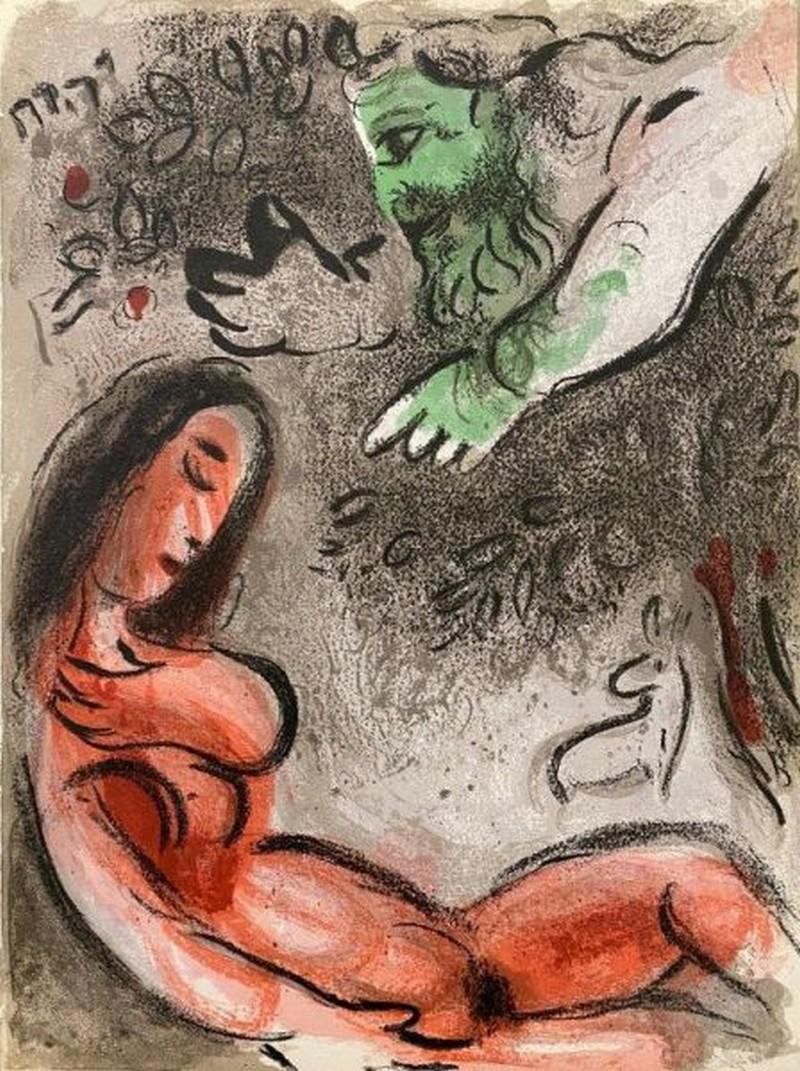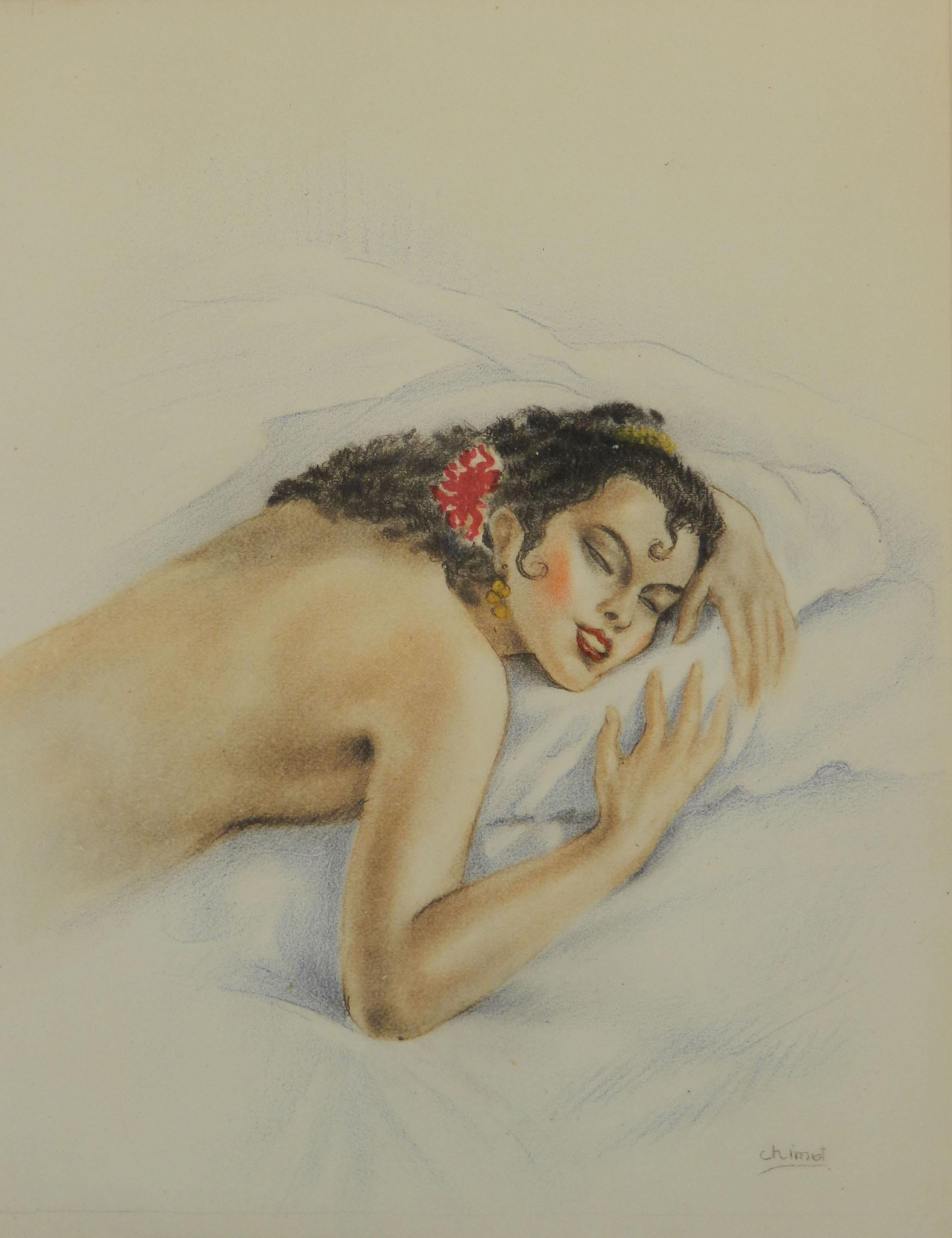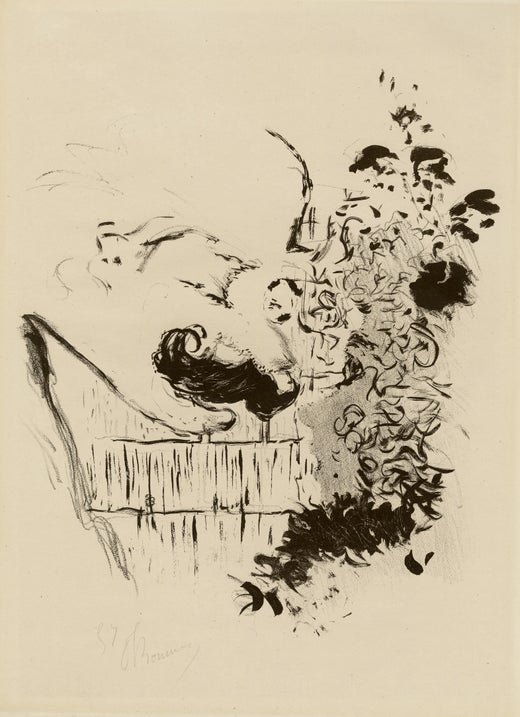Items Similar to Conversation
Want more images or videos?
Request additional images or videos from the seller
1 of 8
Pierre BonnardConversation1893-1894
1893-1894
About the Item
Conversation
Lithograph, 1893-1894
Signed and numbered in pencil lower left (see photo)
Edition: (57/100) 100
Printed on wove paper
Published by Edouard Kleinmann
An early Nabi school print.
An impression of this image is in the Museum of Modern Art, NYC
Reference: Bouvet 28, published state
Condition: Very slight staining around sheet edges.
Image size: 15 x 11 inches
Pierre Bonnard
French artist
Born: October 3, 1867, Fontenay-aux-Roses, France
Died: January 23, 1947, Le Cannet (aged 79)
Pierre Bonnard (born October 3, 1867, Fontenay-aux-Roses, France—died January 23, 1947, Le Cannet) was a French painter and printmaker, a member of the group of artists called the Nabis and afterward a leader of the Intimists. He is generally regarded as one of the greatest colourists of modern art. His characteristically intimate, sunlit domestic interiors and still lifes include The Dining Room (1913) and Bowl of Fruit (c. 1933).
After taking his baccalaureate, in which he distinguished himself in classics, Bonnard studied law at the insistence of his father, and for a short time in 1888 he worked in a government office. In the meantime he attended the École des Beaux-Arts, but, failing to win the Prix de Rome (a prize to study at the French Academy in Rome), he transferred to the Académie Julian, where he came into contact with some of the major figures of the new artistic generation—Maurice Denis, Ker-Xavier Roussel, Paul Sérusier, Édouard Vuillard, and Félix Vallotton. In 1890, after a year’s military service, he shared a studio in Montmartre with Denis and Vuillard. Later they were joined by the theatrical producer Aurélien Lugné-Poë, with whom Bonnard collaborated on productions for the Théâtre de l’Oeuvre, in Paris. At this time he became influenced by Japanese prints, which had earlier attracted the Impressionists.
During the 1890s Bonnard became one of the leading members of the Nabis, a group of artists who specialized in painting intimate domestic scenes as well as decorative curvilinear compositions akin to those produced by painters of the contemporary Art Nouveau movement. Bonnard’s pictures of charming interiors lighted by oil lamps, nudes on voluptuous beds, and Montmartre scenes made him a recorder of France’s Belle Époque. It was typical of his humour and taste for urban life at the time that he illustrated Petites scènes familières and Petit solfège illustré (1893), written by his brother-in-law Claude Terrasse, and executed the lithograph series Quelques aspects de la vie de Paris (“Aspects of Paris Life”), which was issued by the art dealer Ambroise Vollard in 1899. He also contributed illustrations to the celebrated avant-garde review La Revue blanche. A new phase in book illustration was inaugurated with Bonnard’s decoration of the pages in Paul Verlaine’s book of Symbolist poetry, Parallèlement, published by Vollard in 1900. He undertook the illustration of other books during the 1900s.
Bonnard’s ability as a large-scale decorator is sometimes overlooked, in view of his more quiet, domestic paintings in the Intimist style. But about 1906 he painted Pleasure, Study, Play, and the Voyage, a series of four decorations made to resemble tapestries, for the salon of Misia Natanson, the wife of one of the editors of La Revue blanche. These pictures show that he was an heir to the French grand tradition of pictorial design that may be traced to Charles Le Brun, the director of all artistic activity under Louis XIV, and François Boucher, the most fashionable painter in the mid-18th century.
By about 1908 Bonnard’s Intimist period had concluded. A picture such as Nude Against the Light (1908) was painted not only on a bigger scale but also with broader and more colouristic effects. Because of his increasing interest in landscape painting, he had begun painting scenes in northern France. In 1910 he discovered the south of France, and he became the magical painter of this region. The Mediterranean was considered by many of the period to be a source of French civilization. Bonnard was eager to emphasize the connections between his art and France’s classical heritage. This was evident in the pose of certain of his figures, which hark back to ancient Hellenistic sculpture. He was also enamoured of the colouristic tradition of the 16th-century Venetian school. The Abduction of Europa (1919), for example, is in a direct line of descent from the work of Titian.
The subjects of Bonnard’s pictures are simple, but the means by which he rendered such familiar themes as a table laden with fruit or a sun-drenched landscape show that he was one of the most subtle masters of his day; he was particularly fascinated with tricks of perspective, as the Post-Impressionist painter Paul Cézanne had been. In The Dining Room (1913), for example, he employed different levels of perspective and varied the transitions of tone, from warm to cool.
By about 1915 Bonnard realized that he had tended to sacrifice form for colour, so from that point until the late 1920s he painted nudes that reflect a new concern for structure without losing their strong colour values. In the 1920s he undertook a series of paintings on one of his most famous themes—a nude in a bath. From the end of the 1920s onward, the subject matter of his pictures hardly varied—still lifes, searching self-portraits, seascapes at Saint-Tropez on the Riviera, and views of his garden at Le Cannet, near Cannes, where he had moved in 1925 after marrying his model and companion of 30 years, Maria Boursin. These are paintings intense with colour.
The chronological order of Bonnard’s paintings is difficult to determine, for he would make sketches in pencil or colour and then use them as the basis for several pictures on which he would work simultaneously. When working in the studio, he would rely on his memory of the subject and constantly retouch the surface, building up a mosaic of colours. It is impossible, therefore, to give more than approximate dates for many of his works. In 1944 Bonnard illustrated a group of early letters, which were published in facsimile under the appropriate title of Correspondances. Formes et couleurs.
Denys Sutton, noted Art Historian
- Creator:Pierre Bonnard (1867-1947, French)
- Creation Year:1893-1894
- Dimensions:Height: 15 in (38.1 cm)Width: 11 in (27.94 cm)
- Medium:
- Movement & Style:
- Period:
- Condition:
- Gallery Location:Fairlawn, OH
- Reference Number:
Pierre Bonnard
Pierre Bonnard was a French painter, illustrator and printmaker, born in 1867. He is known especially for the stylized decorative qualities of his paintings and his bold use of color. He painted landscapes, urban scenes, portraits and intimate domestic scenes, where the backgrounds, colors and painting style usually took precedence over the subject. He was a founding member of the post-impressionist group of avant garde painters, Les Nabis. He was also a leading figure in the transition from impressionism to modernism.
About the Seller
5.0
Recognized Seller
These prestigious sellers are industry leaders and represent the highest echelon for item quality and design.
Platinum Seller
These expertly vetted sellers are 1stDibs' most experienced sellers and are rated highest by our customers.
Established in 1978
1stDibs seller since 2013
712 sales on 1stDibs
Typical response time: 1 hour
Associations
International Fine Print Dealers Association
- ShippingRetrieving quote...Ships From: Akron, OH
- Return PolicyA return for this item may be initiated within 10 days of delivery.
More From This SellerView All
- Les Pelerins d'Emmaus (The Pilgrims of Emmaus)By Maurice DenisLocated in Fairlawn, OHLes Pelerins d'Emmaus (The Pilgrims of Emmaus) After a 1894 painting by Denis in the Van Gogh Museum (see photo) Color lithograph, 1895 Signed in pencil ...Category
1890s French School Figurative Prints
MaterialsLithograph
- XXe Siecle, No. 34, Mai 1970By Marc ChagallLocated in Fairlawn, OHXXe Siecle, No. 34, Mai 1970 Color lithograph, 1970 Unsigned (as usual for XXeme Siecle edition) From: XXe Siecle, Volume 34, 1970 Published by G. di San Lazzaro for A. Maeght, Paris...Category
1970s French School Figurative Prints
MaterialsLithograph
- Le Clown Blanc (The White Clown)By Marc ChagallLocated in Fairlawn, OHLe Clown Blanc (The White Clown) Lithograph, 1964 Unsigned (as issued by DLM) From: Derriere le Miroir Chagall: Dessins et Lavis, Exposition...Category
1960s French School Figurative Prints
MaterialsLithograph
- XXe Siecle-Hommage a Marc ChagallBy Marc ChagallLocated in Fairlawn, OHXXe Siecle-Hommage a Marc Chagall Color lithograph, 1969 Unsigned as issued by XXe Siecle From: XXe Siecle, Volume, Special Issue Marc Chagall Published by G. di San Lazzaro for A. M...Category
1960s French School Figurative Prints
MaterialsLithograph
- La Naissance d’Annette (Birth of Annette)By Edouard VuillardLocated in Fairlawn, OHLa Naissance d’Annette (Birth of Annette) Color llithograph, 1899 Unsigned (as usual) Edition: 100 Publisher: Ambrose Vollard Printer: Auguste Clot, Paris Condition: Excellent with f...Category
1890s French School Figurative Prints
MaterialsLithograph
- Le Clown Blanc (The White Clown)By Marc ChagallLocated in Fairlawn, OHLe Clown Blanc (The White Clown) Lithograph, 1964 Unsigned (as issued by DLM) From: Derriere le Miroir Chagall: Dessins et Lavis, Exposition Chagall, Galeries Maeght, No. 146, 1964 E...Category
1960s French School Figurative Prints
MaterialsLithograph
You May Also Like
- Jean Picart Le Doux Limited Edition 'Fabric' Lithograph of Tapestry Artist c1964By Jean Picart Le DouxLocated in FRJean Picart Le Doux Limited Edition on to Fabric Lithograph of Woodcutter Tapestry c1964 Marked very well on back by the Artist Jean Picart Le Doux, 1902-1982 French Interesting Fab...Category
1960s French School Figurative Prints
MaterialsLithograph, Fabric
- BAIGNEUSESBy Henri Fantin-LatourLocated in Santa Monica, CAHENRI FANTIN-LATOUR (French 1836-1904) BAIGNEUSES (4e grande planche), 1898 (Hediard 138 II/II) It’s one of 6 works that formed a suite of images published ...Category
1890s French School Figurative Prints
MaterialsLithograph
- DEAUX FEMMES MAORIES ACCROUPIESBy Paul GauguinLocated in Santa Monica, CAPAUL GAUGUIN (French 1848 - 1903) DEAUX FEMMES MAORIES ACCROUPIES. 1894-5 (Kornfield 26: Guerin 87 ) Zincograph (Lithograph) on smooth, cream imitation Japan paper, edition 200. Pu...Category
1890s French School Figurative Prints
MaterialsLithograph
- The MarketBy Henri Le RicheLocated in Middletown, NYStone lithograph in black ink on tissue-thin wove Japon paper, 9 x 11 1/4 inches (228 x 285 mm), full margins. Signed and numbered 43/125 in pencil in the lower margin. Overall mod...Category
Early 20th Century French School Figurative Prints
MaterialsHandmade Paper, Lithograph
- Deck of a Man o' War / Le Vauban (cuirassé)By Paul Leon JazetLocated in Middletown, NYLithograph on Les Lettres et les Arts watermarked cream wove paper with deckle edges, 8 3/4 x 10 1/2 inches (220 x 265 mm), full margins. Signed, titled, and numbered 34/52 in penci...Category
Late 19th Century French School Figurative Prints
MaterialsHandmade Paper, Lithograph
- Bois de la HayeBy Paul HuetLocated in Middletown, NYEtching and lithograph on cream wove paper, 6 x 8 3/4 inches (151 x 220 mm), full margins. With some scattered light spots of yellowing in the margins on the recto, outside of image ...Category
Mid-19th Century French School Landscape Prints
MaterialsHandmade Paper, Etching, Lithograph






